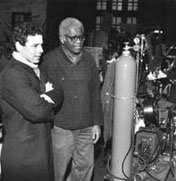
 |
||
 |
||
 |
||
 |
||
 |
After choosing a subject, the Curator of Fine Art develops a plan that describes the exhibit, goals, and costs. Exhibits can be organized by one or more of the following:
- theme
(animals in art, for example)
artist medium (such as oil, watercolor, or pencil) style (romantic, realist, impressionism, etc.) time period genre (landscape, portrait, still life, etc.)technique (painting, drawing, sculpture, photograph, etc.)
The Curator of Fine Art decided to organize the Balancing Act exhibit by artist (Richard Hunt), by
medium (sculpture, drawings, and models) andOne of the goals was to show how Mr. Hunt's work has changed over time and how he responded through his art to what was happening in the world. The title, Balancing Act, has two meanings: The sculptures seem to balance in the air, and Richard Hunt has to balance the different parts of his life and career.
theme (as a retrospective, or review, of the last forty years of the artist's work).
Other Members of the Art Team
Next, a project-planning committee meets. The Director of Art reviews the proposal and, upon approval, schedules the exhibit.
 The
curator contacted Richard Hunt to invite him to exhibit his work. After
Hunt accepted, the curator visited the artist's studio to dicuss the details
of the show.
The
curator contacted Richard Hunt to invite him to exhibit his work. After
Hunt accepted, the curator visited the artist's studio to dicuss the details
of the show.
The registrar, who handles all of the arrangements for lending and borrowing artwork, must prepare the proper documents for any borrowed items in the exhibit.
Curatorial
Research
The
curator
- works with the librarian to gather resource materials to research and write about the artist, the work, and the theme of the exhibit.
- coordinates the exhibit's schedule
- prepares written material for printing, including the exhibit labels, announcements, and reception invitations
- may author a catalog with more in-depth information to accompany the exhibit.
Designing
the Floor Plan
For
this exhibit, the curator planned the physical layout of objects within
the gallery. In the design, he decided to group the sculptures by decade.
He also kept in mind a balance between the larger and smaller pieces.
The preparator builds any exhibit furniture (cases, platforms, pedestals, etc.) needed to display the artwork. In creating the platforms and pedestals for Balancing Act, the preparator had to consider the size and scale of each sculpture.
Team Members
in Other Departments
Meanwhile,
the editor makes sure that the grammar of the written material is correct
and that its content is clear and understandable as she prepares it for
printing.
The graphic artist designs a reception invitation and an exhibition brochure.
The director of development plans an opening reception.
A museum educator creates educational activities for the gallery.
The next step is to pick up the sculpture, move it to the gallery, and install it.
|
|
Copyright © 2000 Illinois State Museum